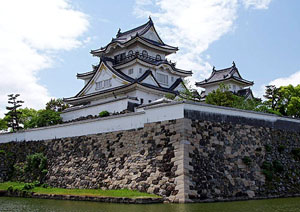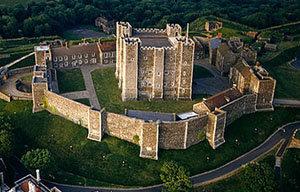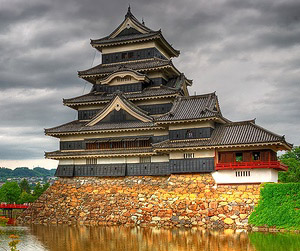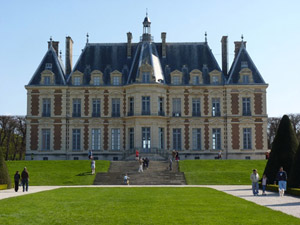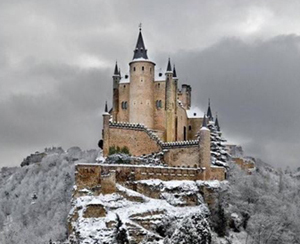Types of Castle and The History of CastlesJapanese Castles |
|
|
|||||||||||||||||||||||||||||
Japanese Castles
Japanese castles are fortresses constructed primarily of wood and stone. They evolved from the wooden stockades of earlier centuries, and came into their best-known form in the 16th century.
Their evolution parallels that of western castles, as their uses were almost identical: defence, strategic control, impressing people who might cause trouble, centre of government, and al residence for feudal lords and their families.
Though they were built to last and used more stone in their construction than most Japanese buildings, castles were still constructed primarily of wood, and many have been destroyed over the years. Today there are more than one hundred castles extant, or partially extant, in Japan, out of around five thousand that once existed
Originally conceived of purely as fortresses, their primary purpose being military defence, Japanese castles were originally placed in strategic locations, along trade routes, roads and rivers. Though castles continued to be built with these considerations in mind, for centuries fortresses were also built to serve as centres of governance. By the Sengoku period, they had come to serve as the homes of daimyo (feudal lords), and served to impress and intimidate rivals not only with their defences, but with their size and elegant interiors, architecture and decorations. |
|
||||||||||||||||||||||||||||
|
|
|||||||||||||||||||||||||||||
|
|
Moats were created by diverting mountain streams. Buildings were made primarily of wattle and daub, using thatched roofs, or, occasionally, wooden shingles. Small ports in the walls or planks could be used to deploy bows or fire guns from. The main weakness of this style was its general instability. Thatch caught fire even more easily than wood, and weather and soil erosion prevented structures from being particularly large or heavy. Eventually, stone bases began to be used, encasing the hilltop in a layer of fine pebbles, and then a layer of larger rocks over that, with no mortar. This support allowed larger, heavier, and more permanent buildings.
Some castle moats would be filled with water only at times of conflict.
The Heian period (794–1185) saw a shift from the need to defend the entire state from invaders to that of lords defending individual mansions or territories from one another. Defensive strategies and attitudes were forced to change and adapt. As factions emerged and loyalties shifted, clans and factions that had helped the Imperial Court became enemies, and defensive networks were broken, or altered through the shifting of alliances.
Fortifications were still made almost entirely out of wood, and were based largely on earlier modes, and on Chinese and Korean examples. But they began to become larger, to incorporate more buildings, to accommodate larger armies, and to be conceived as more long-lasting structures. This mode of fortification, developed gradually from earlier modes and used throughout the wars of the Heian period (770–1185), and deployed to help defend the shores of Kyushu from the Mongol invasions of the 13th century, reached its climax in the 1330s, during the Nanboku-cho period. Chihaya castle and Akasaka castle, permanent castle complexes containing a number of buildings but no tall keep towers, and surrounded by wooden walls, were built by Kusunoki Masashige to be as militarily effective as possible, within the technology and designs of the time.
The beginnings of the shapes and styles now considered to be the "classic" Japanese castle design emerged in the fourteenth century, and castle towns also appeared and developed. Despite these developments, castles remained essentially larger, more complex versions of the simple wooden fortifications of centuries earlier. It was not until the last thirty years of the period of war that drastic changes would occur to bring about the emergence of the type of castle typified by Himeji castle and other surviving castles.
Unlike in Europe, where the advent of the cannon spelled the end of the age of castles, Japanese castle-building was spurred by the introduction of firearms. Firearms first appeared in Japan in 1543, and castle design almost immediately saw developments in reaction, Azuchi castle, built in the 1570s, was the first example of a largely new type of castle, on a larger, grander scale than those that came before, boasting a large stone base, a complex arrangement of concentric baileys, and a tall central tower. Castle were located on plains, rather than on mountains, and relied more heavily on architecture and man-made defenses than on its natural environment for protection. |
|
|||||||||||||||||||||||||||
|
|||||||||||||||||||||||||||||
|
|
Osaka Castle was destroyed by cannon. This reproduction towers above the surroundings. The introduction of the arquebus brought dramatic shifts in battle tactics and military attitudes in Japan. Though these shifts were complex and numerous, one of the concepts key to changes in castle design at this time was that of battle at range. Though archery duels had traditionally preceded samurai battles since the Heian period or earlier, exchanges of fire with arquebuses had a far more dramatic effect on the outcome of the battle; hand-to-hand fighting, while still extremely common, was diminished by the co-ordinated use of firearms.
Oda Nobunaga, one of the most expert commanders in the co-ordinated tactical use of the new weapon, built his Azuchi castle, which has since come to be seen as the paradigm of the new phase of castle design, with these considerations in mind. The stone foundation resisted damage from arquebus balls better than wood or earthworks, and the overall larger scale of the complex added to the difficulty of destroying it. Tall towers and the castle's location on a plain provided greater visibility from which the garrison could employ their guns, and the complex set of courtyards and baileys provided additional opportunities for defenders to retake portions of the castle that had fallen.
Cannon were rare in Japan due to the expense of obtaining them from foreigners, and the difficulty in casting such weapons themselves as the foundries used to make bronze temple bells were simply unsuited to the production of iron or steel cannon. The few cannon that were used were smaller and weaker than those used in European sieges, and many of them were in fact taken from European ships and remounted to serve on land; where the advent of cannon and other artillery brought an end to stone castles in Europe, wooden ones would remain in Japan for several centuries longer. A few castles boasted 'wall guns', but these are presumed to have been little more than large calibre arquebuses, lacking the power of a true cannon. When siege weapons were used in Japan, they were most often trebuchets or catapults in the Chinese style, and they were used as antipersonnel weapons.
There is no record that the goal of destroying walls ever entered into the strategy of a Japanese siege. In fact, it was often seen to be more honourable, and more tactically advantageous on the part of the defender for him to lead his forces into battle outside the castle. When battles were not resolved in this way, out in the open, sieges were almost always undertaken purely by denying supplies to the castle, an effort that could last years, but involved little more than surrounding the castle with a force of sufficient size until a surrender could be elicited. |
|
|||||||||||||||||||||||||||
|
|
|||||||||||||||||||||||||||||
|
|
The crucial development that spurred the emergence of a new type of defensive architecture was, thus, not cannon, but the advent of firearms. Arquebus firing squads and cavalry charges could overcome wooden stockades with relative ease, and so stone castles came into use.
Azuchi Castle was destroyed in 1582, just three years after its completion, but it nevertheless ushered in a new period of castle-building. Among the many castles built in the ensuing years was Hideyoshi's castle at Osaka, completed in 1585. This incorporated all the new features and construction philosophies of Azuchi, and was larger, more prominently located, and longer-lasting. It was the last bastion of resistance against the establishment of the Tokugawa shogunate, and remained prominent if not politically or militarily significant, as the city of Osaka grew up around it, developing into one of Japan's primary commercial centres.
Though stone was sometimes used to shore up defenses or foundations for a few centuries prior, Azuchi's distinctive style of stone base was the first of its kind, and was seen in every castle constructed afterwards. The Japanese used cannon very infrequently, and the heavy stone foundations were more than sufficient to repel arquebus fire. Whether intentionally or not, these foundations apparently proved resilient against Japan's frequent earthquakes.
This period saw the climax of earlier developments towards larger buildings, more complex and concentrated construction, and more elaborate design, both externally and in the castles' interiors. European castle design began to have an impact as well in this period, though the castle had long been in decline in Europe by this point. |
|
|||||||||||||||||||||||||||
|
|||||||||||||||||||||||||||||
|
|
In Japanese politics and warfare, the castle served not only as a fortress, but as the residence of the daimyo, or feudal lord, and as a symbol of his power. Fushimi Castle, which was meant to serve as a luxurious retirement home for Toyotomi Hideyoshi, serves as a popular example of this development. Though it resembled other castles of the period on the outside, the inside was extremely lavishly decorated, and the castle is famous for having a tea room covered in gold leaf. Fushimi was by no means an exception, and many castles bore varying amounts of golden ornamentation on their exteriors. Osaka castle was only one of a number of castles that boasted golden roof tiles, and sculptures of fish, cranes, and tigers. Certainly, outside of such displays of precious metals, the overall aesthetics of the architecture and interiors remained extremely important, as they do in most aspects of Japanese culture.
Some especially powerful families controlled a string of castles, consisting of a main castle (honjo) and a number of satellite castles (shijo) spread throughout their territory. Though the shijo were sometimes full-fledged castles with stone bases, they were more frequently fortresses of wood and earthworks. Often, a system of fire beacons, drums, or conch shells was set up to enable communications between these castles over a great distance. The Hojo family's Odawara Castle and its network of satellites was one of the most powerful examples of this honjo-shijo system; the Hojo controlled so much land that a hierarchy of sub-satellite networks was created |
|
|||||||||||||||||||||||||||
|
|
|||||||||||||||||||||||||||||
|
|
Castles lost their main purpose during a two hundred and fifty years of peace, beginning around 1615 and ending in 1868. Edo period castles, including survivors from the preceding period, therefore no longer needed defenses against outside forces as their primary purpose. They served primarily as luxurious homes for the daimyo, their families and retainers, and to protect the daimyo, and his power base, against peasant uprisings and other internal insurrections. The Tokugawa shogunate, to forestall the amassing of power on the part of the daimyo, enforced a number of regulations limiting the number of castles to one per han (feudal domain). Though there were also, at times, restrictions on the size and furnishings of these castles, and although many daimyo grew quite poor later in the period, daimyo nevertheless sought as much as possible to use their castles as representations of their power and wealth. The general architectural style did not change much from more martial times, but the furnishings and indoor arrangements could be lavish. This restriction on the number of castles allowed each han had profound effects not only politically, as intended, but socially, and in terms of the castles themselves. Where members of the samurai class had previously lived in or around the great number of castles sprinkling the landscape, they now became concentrated in the capitals of the han and in Edo; the resulting concentration of samurai in the cities, and their near-total absence from the countryside and from cities that were not feudal capitals (Kyoto and Osaka in particular) were important features of the social and cultural landscape of the Edo period. Meanwhile, the castles in the han capitals inevitably expanded, not only to accommodate the increased number of samurai they now had to support, but also to represent the prestige and power of the daimyo, now consolidated into a single castle. Edo castle, expanded by a factor of twenty between roughly 1600 and 1636 after becoming the shogunal seat. Though obviously something of an exception, the shogun not being a regular daimyo, it nevertheless serves as a fine example of these developments. These vastly consolidated and expanded castles, and the great number of samurai living, by necessity, in and around them, thus led to an explosion in urban growth in 17th century Japan. As contact with Western powers increased in the middle of the 19th century, some castles such as Goryokaku castle in Hokkaido were turned once again to martial purposes. No longer needed to resist samurai cavalry charges, or arquebus squads, attempts were made to convert Goryokaku, and a handful of other castles across the country, into defensible positions against the cannon of Western naval vessels. |
|
|||||||||||||||||||||||||||
|
|
|
|||||||||||||||||||||||||||
|
|||||||||||||||||||||||||||||
|
|
More on Types of Castle and History of Castles
Click on any of the following links to learn more about specific types of castle
|
|
|||||||||||||||||||||||||||
|
|
|
|
|||||||||||||||||||||||||||
|
|
|||||||||
| :::: Link to us :::: Castle and Manor Houses Resources ::: © C&MH 2010-2014 ::: contact@castlesandmanorhouses.com ::: Advertising ::: |




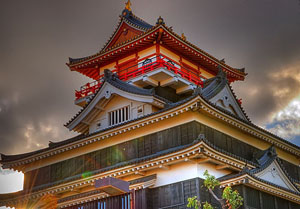
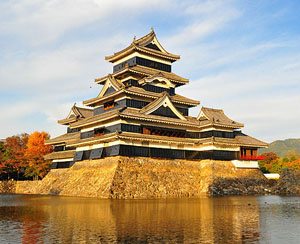

.jpg)
